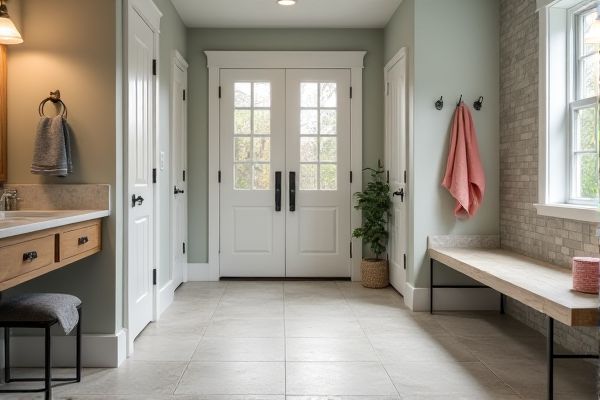
Smooth tiles offer a sleek, modern look that is easy to clean and maintain, making them ideal for busy mudrooms, while textured tiles provide better slip resistance and a rustic aesthetic that can hide dirt and wear more effectively. Explore the rest of the article to help you decide which tile best suits your mudroom's style and functionality.
Table of Comparison
| Feature | Smooth Tile | Textured Tile |
|---|---|---|
| Slip Resistance | Low, can be slippery when wet | High, provides better grip and safety |
| Maintenance | Easy to clean and maintain | Requires more effort to clean dirt from grooves |
| Appearance | Sleek, modern, and polished | Rustic, natural, and visually dynamic |
| Durability | Durable but scratches more visible | Durable with scratches less noticeable |
| Ideal Use | Low traffic mudrooms, decorative | High traffic mudrooms, functional spaces |
| Cost | Generally lower price | Usually higher due to texture complexity |
Introduction: Choosing the Right Tile for Your Mudroom
Smooth tiles offer a sleek, easy-to-clean surface ideal for mudrooms experiencing frequent foot traffic and spills, while textured tiles provide enhanced slip resistance and durability in wet or muddy conditions. Your choice should balance maintenance preferences with safety needs, considering the typical usage and moisture levels in your mudroom. Selecting the right tile ensures a functional, safe, and stylish entryway tailored to your home's demands.
Smooth Tile: Key Features and Benefits
Smooth tiles in mudrooms offer a sleek, easy-to-clean surface that resists stains and water absorption, making maintenance straightforward and efficient. Their uniform texture provides a modern aesthetic and reduces the risk of dirt buildup, enhancing hygiene in high-traffic areas. This type of tile is highly durable, suitable for mudrooms exposed to mud and moisture, while supporting seamless integration with radiant floor heating systems.
Textured Tile: Key Features and Benefits
Textured tiles in mudrooms offer enhanced slip resistance, making them ideal for areas prone to moisture and dirt. Their surface irregularities provide better grip, reducing the risk of slips and falls, while also hiding dirt and wear more effectively than smooth tiles. Durable and low-maintenance, textured tiles maintain their aesthetic appeal even in high-traffic mudroom environments.
Slip Resistance: Safety Considerations in Mudrooms
Textured tiles provide enhanced slip resistance in mudrooms by offering increased grip and reducing the risk of falls, especially in wet or muddy conditions. Smooth tiles, while aesthetically pleasing, tend to become slippery when wet, posing a safety hazard in high-traffic entry areas. Choosing slip-resistant textured tiles with high COF (Coefficient of Friction) ratings ensures a safer environment by minimizing slip-related accidents.
Maintenance and Cleaning: Smooth vs. Textured Surfaces
Smooth tiles in mudrooms are easier to clean and maintain, as their flat surfaces resist dirt buildup and allow for quick wiping of spills and mud. Textured tiles, while providing better slip resistance, tend to trap dirt in their grooves and crevices, requiring more intensive scrubbing and specialized cleaning tools. Your choice between smooth and textured tile should consider the balance between ease of maintenance and safety needs based on foot traffic and exposure to mud.
Aesthetic Appeal: Style Options for Mudroom Tiles
Smooth tiles offer a sleek, modern aesthetic with a polished surface that enhances light reflection, making your mudroom appear brighter and more spacious. Textured tiles provide a rustic, natural look that enhances grip and durability, ideal for high-traffic mudroom areas prone to dirt and moisture. Choosing between smooth and textured options depends on your desired style and functional needs, ensuring your mudroom's design complements the overall home decor while maintaining practicality.
Durability and Longevity: Which Tile Lasts Longer?
Smooth tiles typically offer greater durability and longevity in mudrooms due to their dense, non-porous surfaces that resist moisture absorption and staining. Textured tiles, while providing enhanced slip resistance, may experience faster wear and accumulation of dirt in crevices, potentially reducing their lifespan. Porcelain smooth tiles with a high PEI (Porcelain Enamel Institute) rating outperform textured natural stone tiles in maintaining appearance and structural integrity over time in high-traffic areas like mudrooms.
Cost Comparison: Smooth Tile vs. Textured Tile
Smooth tile generally costs less than textured tile due to simpler manufacturing processes and lower material usage. Textured tile, designed to provide enhanced slip resistance in mudrooms, often involves more complex production techniques, increasing its price by 10-30% compared to smooth tile. When selecting tiles for Your mudroom, weigh the upfront cost difference against long-term safety benefits and maintenance requirements.
Installation Process: What to Expect
Smooth tile installation in a mudroom typically involves a straightforward process with easy surface preparation, precise alignment, and minimal grout cleanup due to its even texture. Textured tile requires extra attention during installation to ensure proper adhesion, avoid air pockets, and carefully clean grout from crevices, which may increase labor time and complexity. Professional installers often recommend textured tiles for mudrooms when slip resistance is a priority, despite the slightly more involved installation process.
Final Verdict: Best Tile Choice for Your Mudroom
Smooth tiles offer easy cleaning and a sleek look, making them ideal for mudrooms prone to dirt and moisture. Textured tiles provide better slip resistance, enhancing safety in wet conditions commonly found in entryways. Your best choice depends on balancing aesthetics, maintenance, and safety needs for your mudroom space.
 homyna.com
homyna.com